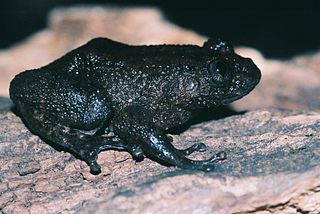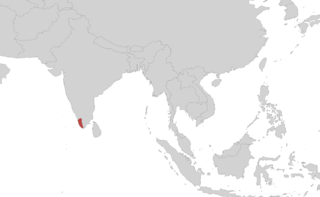
Agumbe is a settlement situated in the Thirthahalli taluka of Shimoga district, Karnataka, India. It is nestled in the thickly forested Malenadu region of the Western Ghats mountain range. Owing to its high rainfall, it has received the epithet of "The Cherrapunji of South India", after Cherrapunji, one of the rainiest places in India.

Nyctibatrachus is a genus of frogs endemic to the Western Ghats of southwestern India. Their common name is night frogs. Their scientific name also means "night frog", in reference to their habits and dark color. They are the only extant members of the monotypic subfamily Nyctibatrachinae. Currently, 35 species belong to Nyctibatrachus.

Ichthyophis beddomei is a species of caecilian in the family Ichthyophiidae. This species is distributed widely in the Western Ghats in southern India. The nominal species might be a composite of several cryptic species. It is also known as the yellow-striped caecilian, Beddome's caecilian, or Nilgherries caecilian.

The Bombay caecilian is an amphibian found in India. This rather large species is found in the northern Western Ghats. The eyes are distinct and surrounded by a light ring. The tentacle is placed closer to the lip than the eye. A dark brown or greyish-brown species, it has no lateral stripes.

Ichthyophis tricolor, the three-colored caecilian or Maddatorai caecilian, is an amphibian endemic to the Western Ghats, India. Its taxonomic status is unclear, including its relationship with Ichthyophis beddomei and the possibility of cryptic species.

Uraeotyphlus interruptus, also known as the Chengalam caecilian, is a species of caecilian in the family Ichthyophiidae. It is endemic to the Western Ghats in southern India and is only known from its type locality, Chengalam village in Kerala.
Uraeotyphlus malabaricus is a species of caecilian in the family Ichthyophiidae. It is endemic to the Western Ghats of India and is known from its type locality, "Malabar" in Kerala, and from the Nilgiri mountains in Tamil Nadu. It is known with several common names: Malabar tailed caecilian, Nilgiris caecilian, Malabar caecilian, and white-lipped caecilian.

Uraeotyphlus menoni, also known as Menon's caecilian or Kerala caecilian, is a species of caecilian in the family Ichthyophiidae. It is endemic to the state of Kerala in the Western Ghats, India. The specific name menoni honours K. Ramunni Menon, collector of the holotype who later became the vice-chancellor of the University of Madras.

Uraeotyphlus oxyurus, also known as the red caecilian, sharp-nosed caecilian, dark-brown caecilian, pale-throated caecilian, or harp-tailed caecilian, is a species of caecilian in the family Ichthyophiidae. It is endemic to the Western Ghats in Kerala and Tamil Nadu, southern India.
Gegeneophis carnosus is a species of caecilian found in Karnataka and Kerala states, India. Its common name Periah Peak caecilian refers to its type locality, though it is also known under names blind caecilian and pink blind caecilian.
Gegeneophis ramaswamii, common names Tenmalai caecilian, Tenmalai blind caecilian, Ramaswami's caecilian, and forest caecilian is a species of caecilian. It is endemic to the southern portion of the Western Ghats, India, and is recorded from Kerala and Tamil Nadu. The specific name ramaswamii honours L. S. Ramaswami, an Indian herpetologist.
Gegeneophis seshachari, the Seshachari's caecilian, is a species of caecilian found in the Western Ghats of India. It is only known from its type locality Dorle village, Ratnagiri district in Maharashtra.
Battersby's caecilian is a slender species of caecilian endemic to the Western Ghats, India. It has a flesh-coloured body, making it look very much like a large earthworm.

The Western Ghats in India are home to several species of caecilians (Gymnophiona). Caecilians are legless, burrowing amphibians which mostly live in leaf litter, loose soil, under rocks and decaying logs. They are also found in agricultural fields and only surface during the monsoon. The body is elongated and smooth with a slimy skin. The smaller caecilians superficially resemble earthworms while the larger ones are often mistaken for snakes. However, they can be told apart from earthworms by the presence of eyes, teeth and skeleton and from snakes by the lack of scales on skin. The eyes in caecilians are not well developed which is most likely to be because of their burrowing life style. They are considered as rare which is apparently due to their subterranean habits. To see them one has to search carefully and be at the right place and at the right time. There are few places where they are common, but, at least one species was reported to be abundant in agricultural fields in Kerala. The larger caecilians can resemble snakes, but their skin is smooth, not scaly.

The Dattatreya night frog is a species of frog in the family Nyctibatrachidae first described in the Shola forests around the Dattatreya Peeta in the Chikkamagaluru district of Karnataka. It is still known only from this part of the Western Ghats, India.
Gegeneophis is a genus of amphibians in the family Indotyphlidae. They are found in southern and northeastern India.

The Mhadei Wildlife Sanctuary is a 208.5-km2 (80.5-mi2) protected area in the Indian state of Goa in the Western Ghats of South India. It is located in the North Goa District, Sattari taluka near the town of Valpoi. The sanctuary is an area of high biodiversity, and is being considered to become a Project Tiger tiger reserve because of the presence of Bengal tigers.
Nirmal Ulhas Kulkarni is a herpetologist, field ecologist, conservationist, and wildlife photographer. Director (Ecology) of Wildernest Nature Resort, an eco-tel in the Chorla Ghats (Goa), Chairman of the Mhadei Research Centre, Team Lead of Hypnale Research Station and promoter of HERPACTIVE, a study initiative on Herpetofauna. As of December 2012, he lives in Goa.

Ichthyophis kodaguensis, also known as the Kodagu striped Ichthyophis, is a species of caecilian in the family Ichthyophiidae. It is endemic to the southern Western Ghats, India. All confirmed records are from southern Karnataka state, although it is also reported from adjacent Kerala.












